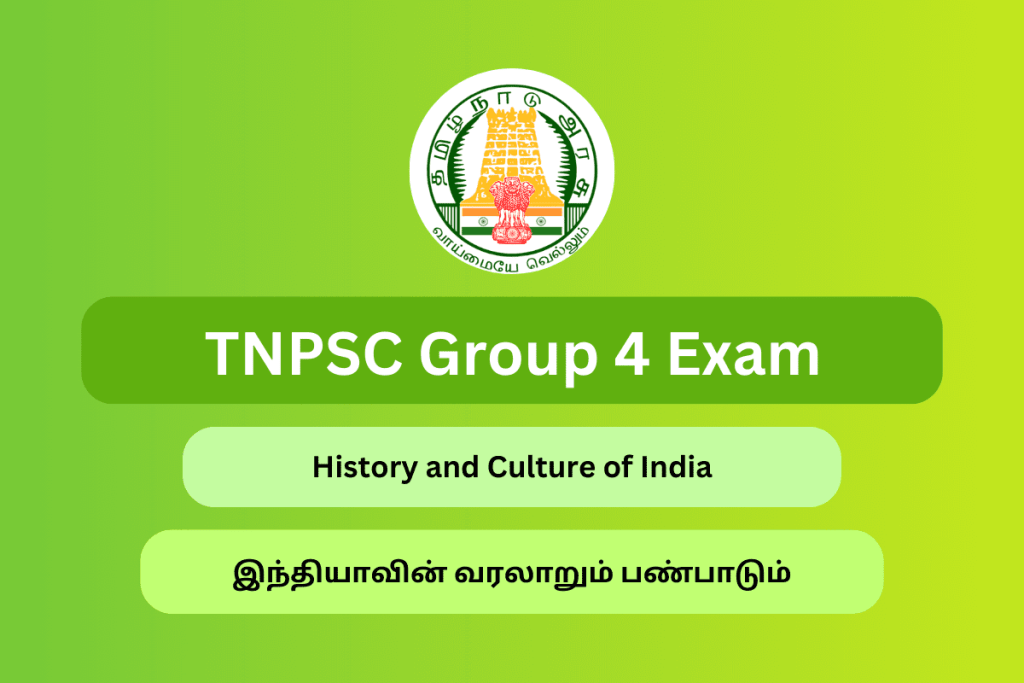Unveiling the Indian History and Culture: A Comprehensive Guide for TNPSC Group 4 Aspirants
History and Culture of India constitute a crucial segment of the TNPSC Group 4 examination, offering insights into the rich heritage, traditions, and historical developments that have shaped the Indian subcontinent over millennia. In this detailed article, we will explore the significance of Indian History and Culture in the examination and delve into various aspects covered by the syllabus.

Understanding the TNPSC Group 4 Syllabus on History and Culture of India
The History and Culture of India segment in TNPSC Group 4 examination encompass a wide array of topics, including ancient, medieval, and modern history, art and architecture, literature, religions, cultural practices, and socio-political movements. Candidates are expected to have a comprehensive understanding of these topics to excel in the examination.
| History and Culture of India இந்தியாவின் வரலாறு மற்றும் பண்பாடு |
TNPSC Group 4 Study Materials for Ancient India
Exploring Ancient History: Ancient India witnessed the rise and fall of numerous civilizations, including the Indus Valley Civilization, Vedic period, Mauryan and Gupta empires, and the advent of Buddhism and Jainism. Candidates should be familiar with key events, rulers, cultural achievements, and contributions of ancient Indian civilizations to art, literature, and philosophy.
- TNPSC Group 4 Study Materials for Development Administration in Tamil Nadu
- TNPSC Group 4 Study Materials for Tamil Nadu – History, Culture and Socio-Political Movements
- TNPSC Group 4 Study Materials for Indian National Movement
TNPSC Group 4 Study Materials for Medieval India
Diving into Medieval History: Medieval India was characterized by the establishment of powerful empires, including the Delhi Sultanate, Mughal Empire, and regional kingdoms. Candidates should understand the socio-political developments, religious movements, cultural exchanges, and architectural marvels of the medieval period, including the impact of Islamic and European influences.
Study Materials for South Indian History
Analyzing South Indian History: Modern Indian history covers the period from the advent of European trading companies to the struggle for independence and post-independence developments. Candidates should have knowledge of colonial rule, the Indian freedom struggle, key personalities, events, and movements such as the Indian National Congress, Partition of India, and integration of princely states.
TNPSC Group IV Study Materials for Indian Culture
Understanding Art and Architecture: Indian art and architecture exhibit a rich cultural heritage, ranging from ancient cave temples and stupas to medieval forts, palaces, and Mughal monuments. Candidates should be familiar with architectural styles, symbolism, and techniques employed in the construction of iconic structures such as the Taj Mahal, Qutub Minar, and Khajuraho temples.
Exploring Literature and Cultural Practices: Indian literature encompasses a vast body of literary works in various languages, including Sanskrit, Tamil, Persian, and regional languages. Candidates should understand the contributions of literary figures, poets, and scholars to Indian literature and their impact on cultural practices, traditions, and societal norms.
| Characteristics of Indian Culture இந்தியப் பண்பாட்டின் இயல்புகள் | 10th Std – [ Socio-Religious Reform Movements in the 19th Century ] | 10th Std – [ 19ஆம் நூற்றாண்டில் சமூக, சமய சீர்திருத்த இயக்கங்கள் ] |
| 11th Std – [ Rise of Territorial Kingdoms and New Religious Sects ] | 11th Std – [ பிரதேச முடியரசுகளின் தோற்றமும் புதிய மதப்பிரிவுகள் உருவாக்கமும் ] | |
| 11th Std – [ Cultural Syncretism: Bhakti Movement in India ] | 11th Std – [ பண்பாட்டு ஒருமைப்பாடு: இந்தியாவில் பக்தி இயக்கம் ] | |
| 11th Std – [ Towards Modernity ] | 11th Std – [ நவீனத்தை நோக்கி ] | |
| 12th Std – [ Ethics ] | 12th Std – [ Ethics ] | |
| Unity in Diversity – Race, Language, Custom வேற்றுமையில் ஒற்றுமை – இனம், மொழி வழக்காறு | 6th Std Term 1 – [ Understanding Diversity ] | 6th Std Term 1 – [ பன்முகத் தன்மையினை அறிவோம் ] |
| India as a Secular State இந்தியா ஒரு மதச்சார்பற்ற நாடு | 8th Std – [ Understanding Secularism ] | 8th Std – [ சமயச்சார்பின்மையை புரிந்துக்கொள்ளுதல் ] |
TNPSC Group 4 Preparation Strategies 2024
Effective Preparation Strategies: To excel in the History and Culture of India section of TNPSC Group 4 examination, aspirants can adopt the following preparation strategies:
- Study from Standard Textbooks: Refer to standard textbooks on Indian History and Culture recommended for competitive examinations to build a strong conceptual foundation.
- Utilize Visual Aids: Utilize maps, diagrams, photographs, and illustrations to visualize historical events, architectural structures, literary works, and cultural practices effectively.
- Analyze Historical Documents: Study primary and secondary sources such as inscriptions, manuscripts, and historical documents to gain insights into India’s history, culture, and socio-political movements.
- Solve Previous Year Papers: Solve previous year question papers and attempt mock tests to familiarize yourself with the exam pattern, question types, and time management strategies.
- Stay Updated: Keep abreast of recent developments in Indian History and Culture, including archaeological discoveries, reinterpretations of historical events, and cultural festivals.
- Focus on Conceptual Understanding: Instead of rote memorization, focus on understanding the context, significance, and implications of historical events, cultural achievements, and socio-political movements in India.
Conclusion on TNPSC Group IV History and Culture of India
In conclusion, mastering the History and Culture of India is essential for success in the TNPSC Group 4 examination. By delving into India’s rich heritage, traditions, and historical developments, aspirants can enhance their knowledge and analytical skills, thereby increasing their chances of scoring well in this section of the examination. Remember, a deep understanding of Indian History and Culture not only aids in examination preparation but also fosters a sense of pride and appreciation for India’s diverse and vibrant cultural mosaic.









